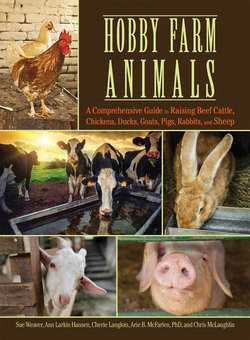Читать книгу Hobby Farm Animals - Chris McLaughlin - Страница 4
На сайте Литреса книга снята с продажи.
Beef Breeds
ОглавлениеUntil the middle of the eighteenth century, cattle were tough, multipurpose animals that were not selectively bred for any specialized purpose. Differences in size, color, and build were simply results of groups’ being isolated from one another in remote settlements. Then, in 1760, Robert Bakewell, an Englishman, began the first known systematic breeding program to improve the uniformity and appearance of his cattle. The results were published in 1822 in George Coates’s Herd Book of the Shorthorn Breed, the first formal recognition of a cattle breed. Other breed herd books soon followed, and, as the concept of breeding for a specific purpose spread, cattle were divided into two main categories: those bred primarily for milk production and those bred primarily for beef production. Even the original dual-purpose Shorthorn breed has been split into Shorthorns for beef and Shorthorns for milking.
More than five hundred breeds of cattle exist in the world today, although only a few are common in the United States. Milking Shorthorn; the ubiquitous black-and-white Holstein; and the rarer Guernsey, Brown Swiss, Ayrshire, and Jersey make up the six primary dairy breeds in the United States. All dairy breeds produce excess bull calves that are raised for beef, and plenty of beef operations are built on dairy calves.
Hereford cattle, with their familiar white faces, red bodies, and white markings, have been the backbone of the American beef industry since a few decades after their arrival in 1847. The Black Angus, first brought to the United States in 1873, is now almost as numerous as the Hereford, while the breed’s offshoot, Red Angus, established its own breed registry in the mid-1900s. These three breeds, along with the Shorthorn, Scottish Highland, Dexter, Devon, and Galloway breeds, are the major British breeds of beef cattle, so designated because they all originated in England, Scotland, Ireland, or Wales. In general, the British beef breeds are smaller, fatten faster, and are more tolerant of harsh conditions than the continental breeds.
The continental breeds from Europe are generally larger and slower to mature but offer a bigger package of beef to the producer. The most common are the Charolais, the Limousin, and the Saler from France; the Simmental from Switzerland; and the Gelbviehs from Austria and West Germany.
Historically, the term cattle was used to refer to all varieties of four-legged livestock, including horses, goats, and sheep. When referring specifically to bovines, ranchers used the term neat cattle. Only in the past 100–150 years has the meaning of the word cattle changed to refer only to domesticated bovines of the Bos genus.
In the United States, new breeds have been developed that tolerate southern heat better than do the European imports. The famous Texas Longhorn, which developed mostly on its own from Spanish cattle brought over by colonists, provided the starting foundation for American ranching. The American Brahman was developed from Indicus-type imports and then was crossed with different European breeds to create the Santa Gertrudis, the Brangus, the Beefmaster, and several other uniquely American cattle breeds.
When well cared for, any breed of cattle will produce good beef. Look for a breed suited to your climate and pasture type and, if the income is important, to the prospective buyers of your beef. Auction-barn buyers and finishers will have definite preferences. Most important, get something you like. You may fall in love with the Oreo-cookie markings of the Belted Galloway, the shaggy look and big horns of the Scottish Highland, or the gentle disposition of the Hereford.
Endangered Breeds
Of the hundreds of cattle breeds adapted to an enormous range of climates and conditions throughout the world, many are now endangered. The Livestock Conservancy lists fifteen breeds in the United States that need help to survive. On the “Critical” list, defined as breeds that have fewer than 200 US registrations each year, are the Canadienne, Dutch Belted, Florida Cracker, Kerry, Lincoln Red, Milking Devon, Milking Shorthorn (native), Randall, and Texas Longhorn. On the “Threatened” list, with fewer than 1,000 registrations each year, are the Ancient Red Park, Pineywoods, and Red Poll. The “Watch” list, with fewer than 2,500 registrations, includes the once-popular Ayrshire and Guernsey, along with the Galloway.
Highland cattle have a distinctive look that appeals to many.
